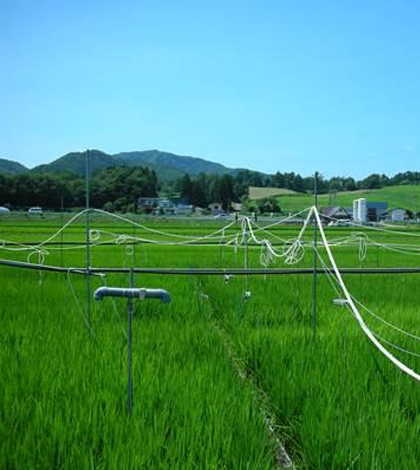Analysis of 13 studies shows elevated atmospheric CO2 inhibits plants’ nitrogen uptake, lowers protein content

A FACE experiment in Japan examines the impact of heightened atmospheric CO2 levels on nitrogen uptake in rice. (Credit: Kazuhiko Kobayashi)
Together with water, carbon dioxide provides plants with the materials to photosynthesize sunlight into energy-providing sugars. But more carbon dioxide doesn’t necessarily mean bigger, healthier plants.
As global climate change causes atmospheric carbon dioxide levels to swell, some plants are inhibited in their ability to absorb nitrogen, a nutrient by which growth is limited in most terrestrial environments.
Researchers from Sweden’s University of Gothenburg uncovered the relationship between nitrogen uptake and rising carbon dioxide through a study examining the results of 13 free-air carbon dioxide enrichment, or FACE, experiments.
The results of their work are published online in the journal Global Change Biology.
Johan Uddling, senior lecturer at the university’s Department of Biological and Environmental Sciences, said the study was inspired by the results of an earlier meta-analysis exploring how wheat responds to carbon dioxide and ozone.
“We unexpectedly found that grain protein concentration was reduced under elevated CO2, even if grain biomass yield was unaffected,” he said. “We wanted to see if this was the case also in other types of ecosystems.”
Including only what Uddling called “the most ecologically realistic studies available worldwide,” the new study compiled results from experiments conducted in grassland, cropland and forest ecosystems in eight countries.
Uddling himself participated in one of the studies: A FACE experiment in Wisconsin that analyzed the impact of elevated carbon dioxide and ozone on aspen water use.
The experiments revealed that nitrogen content in plant tissue is reduced as carbon dioxide levels rise, regardless of ecosystem. Lower nitrogen content equates to reduced protein content, which Uddling says raises concerns over food security in low-income regions, where many people already experience protein deficiencies.
“Future crop improvement could potentially minimize the negative effect, but it is yet too early to say how this will be achieved,” Uddling said.
The study found that the nitrogen-limiting effect held whether or not the plants’ growth increased, even when fertilizer was applied. This challenges previous hypotheses, which suggested that excess carbon dioxide caused plants to grow at a faster rate than nitrogen could be absorbed.
Uddling said there were two major exceptions to the rule: legumes, which form symbiotic relationships with nitrogen-fixing bacteria, and certain grass species that utilize a unique photosynthetic metabolism.
Determining the mechanisms responsible for the nitrogen-limiting effect provided a challenge, even through the scientific review process, Uddling said. But the researchers’ efforts could help improve food security in an uncertain future.
“We plan to continue this work with a stronger focus on agricultural crops,” Uddling said. “Hopefully both by looking at plausible mechanisms in field experiments and by synthesizing data in the literature.”
Top image: A FACE experiment in Japan examines the impact of heightened atmospheric CO2 levels on nitrogen uptake in rice. (Credit: Kazuhiko Kobayashi)





0 comments